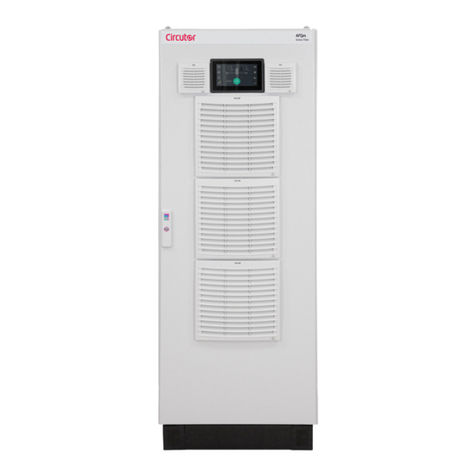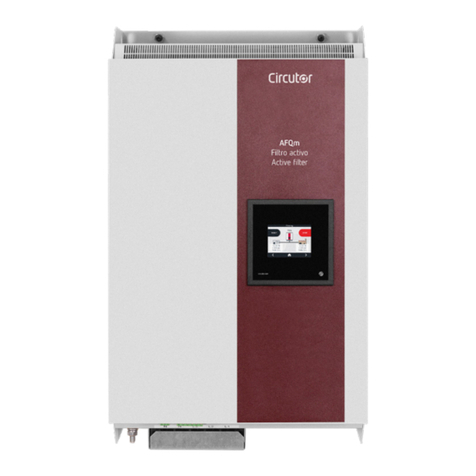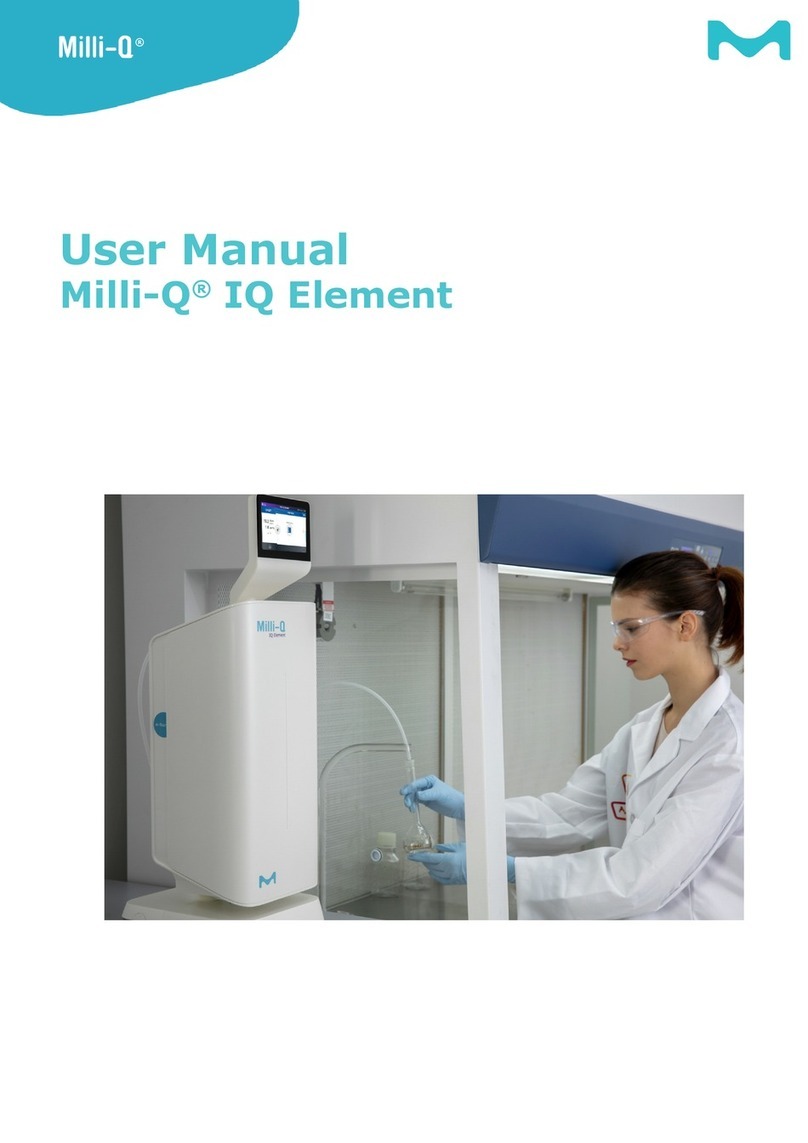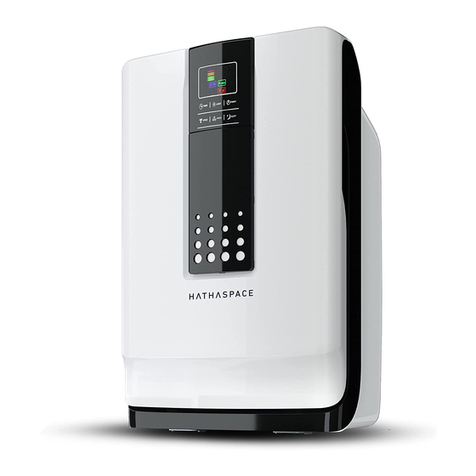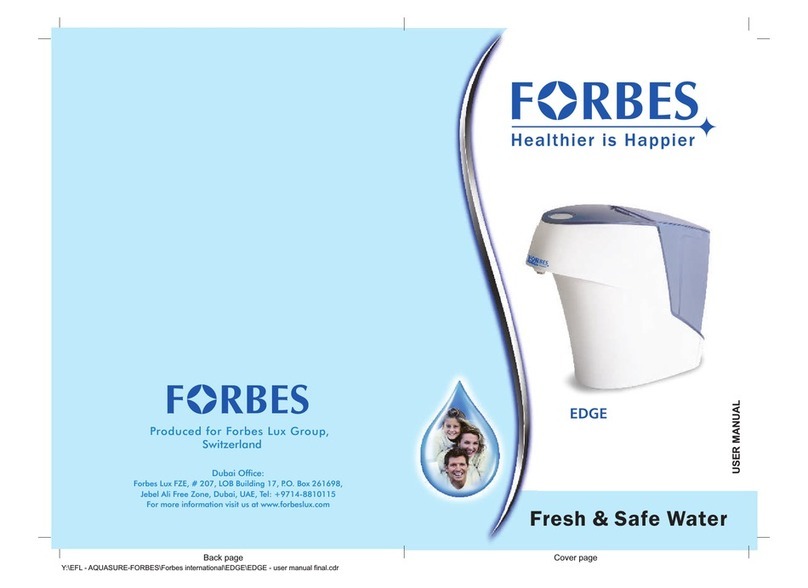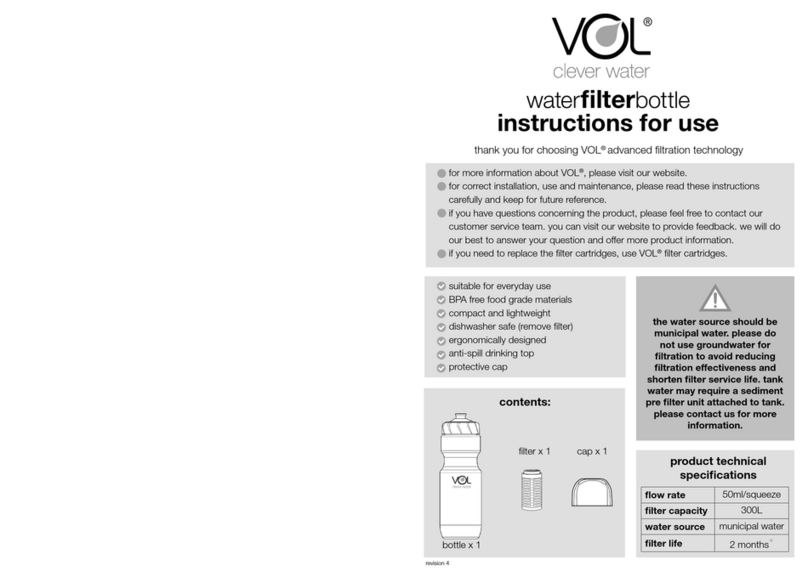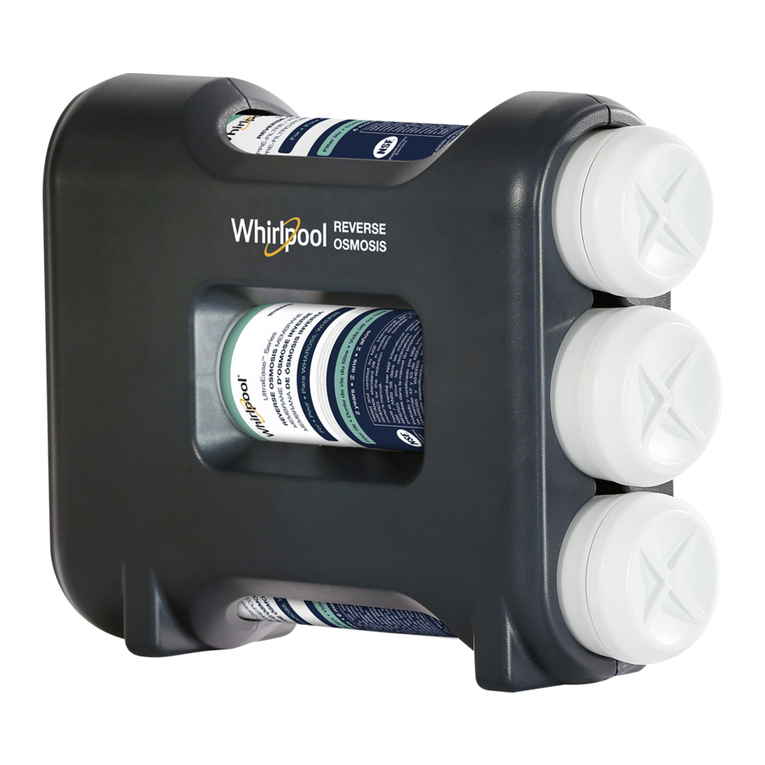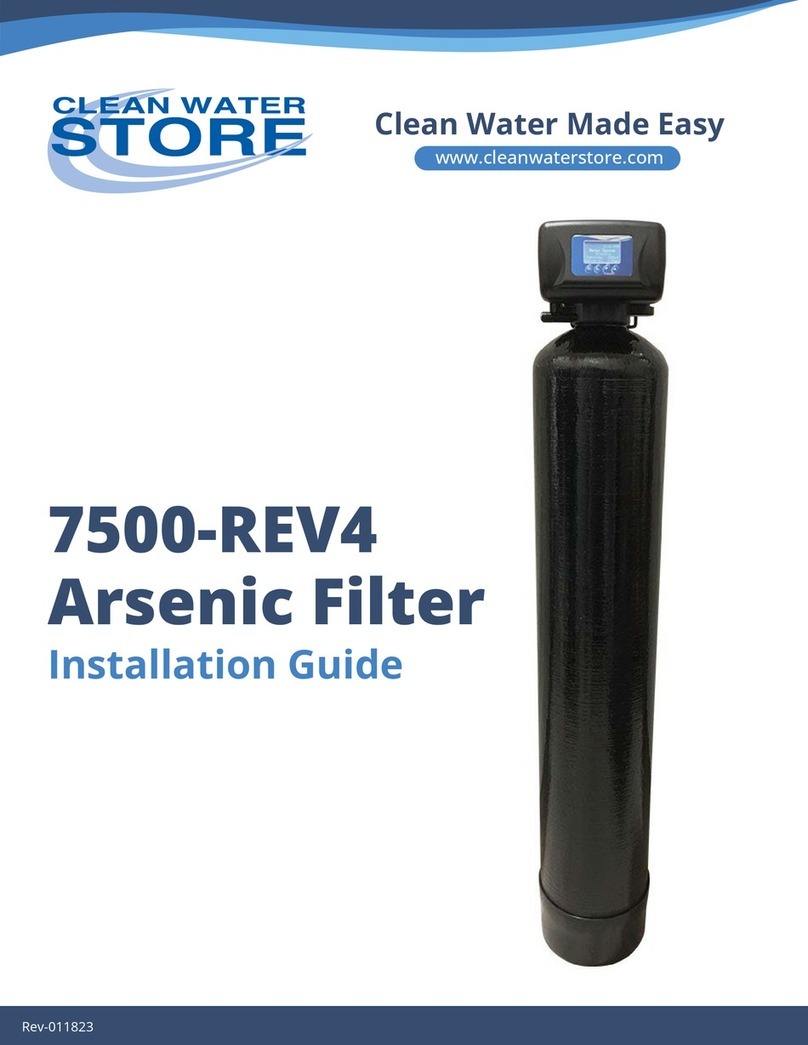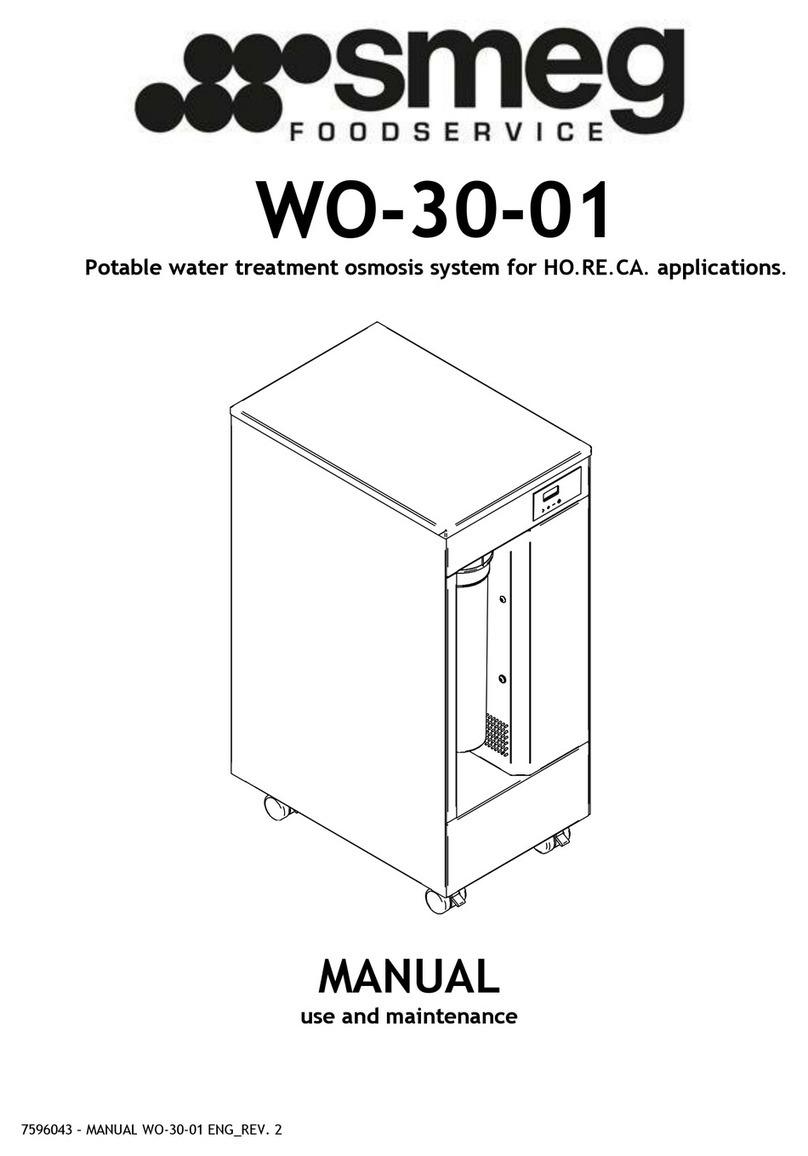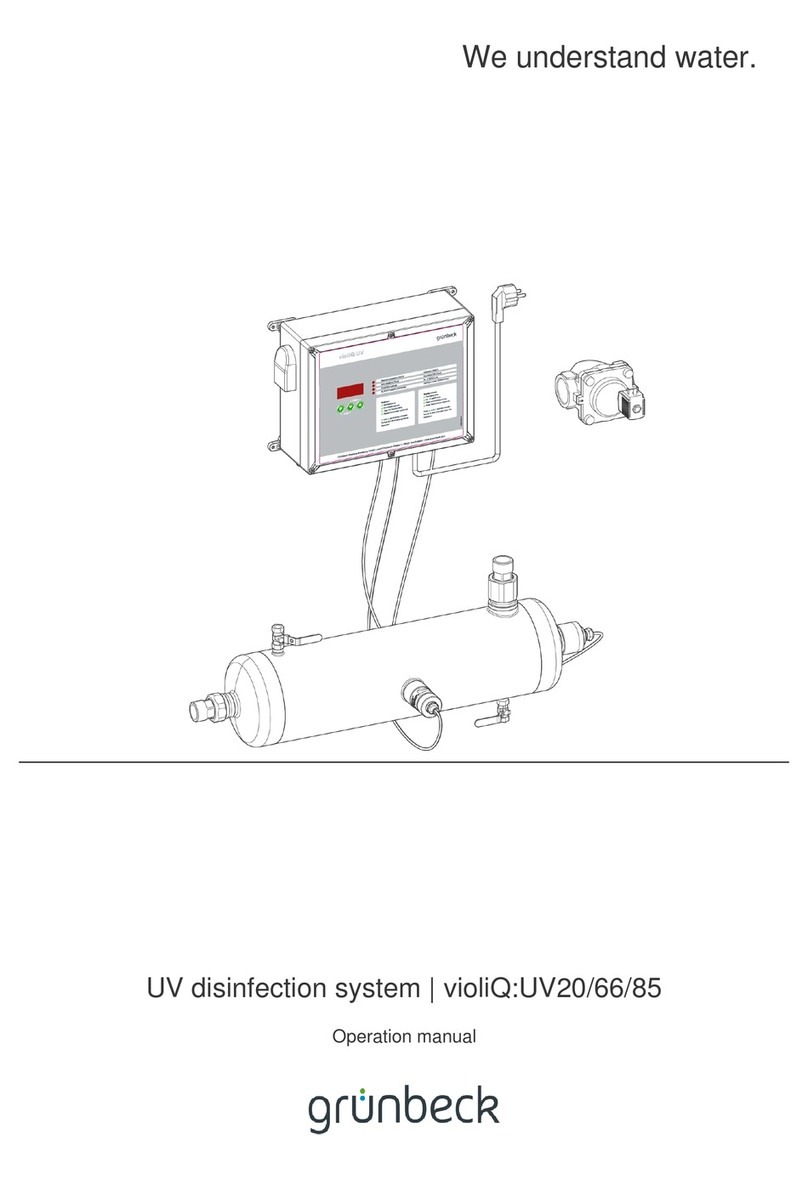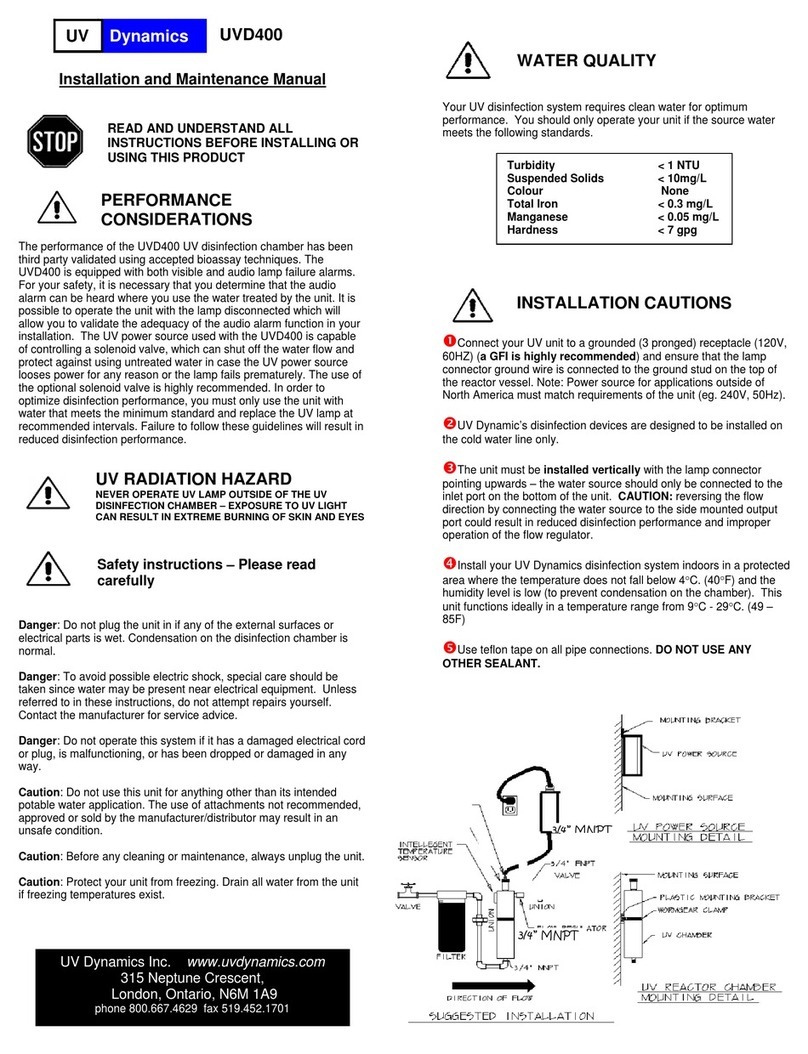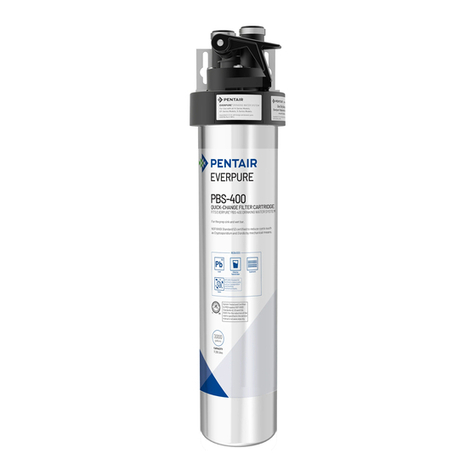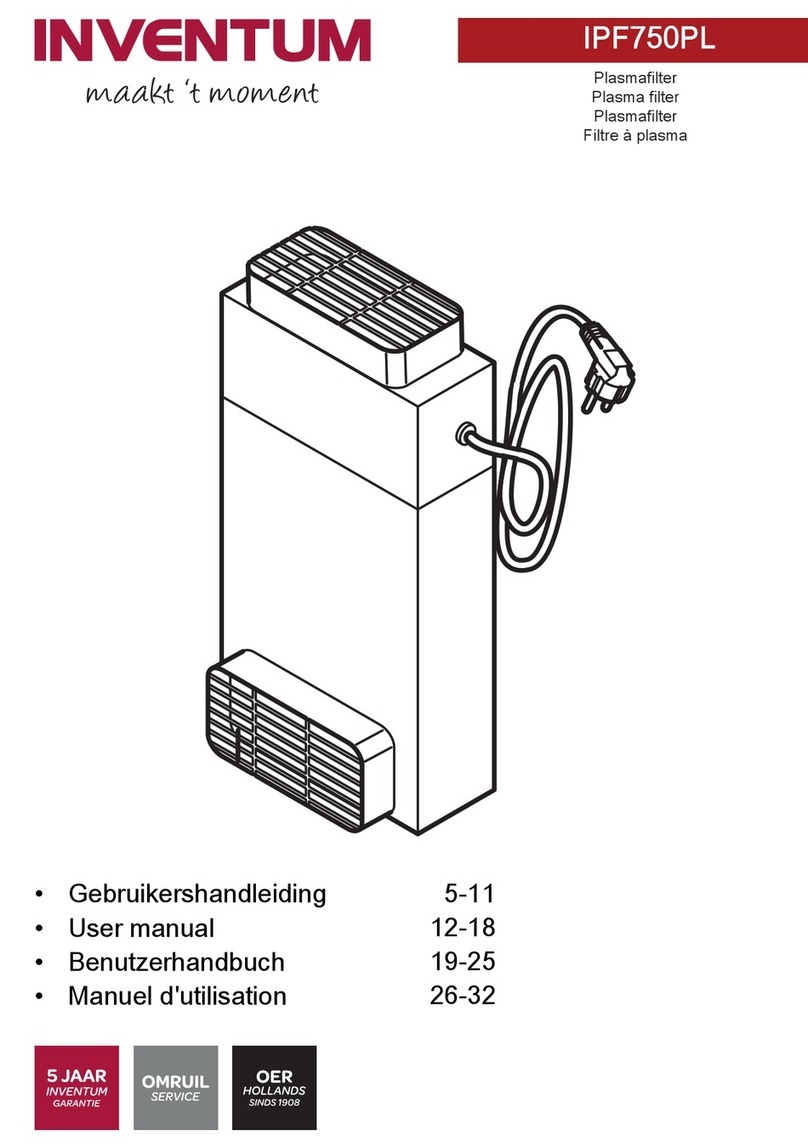Circutor AFQm 30 A User manual

INSTRUCTION MANUAL
Active Parallel Multi-Function Filter
AFQm
(M217B01-03-21A)

2
AFQm
Instruction Manual

3
Instruction Manual
AFQm
SAFETY PRECAUTIONS
DANGER
Warns of a risk, which could result in personal injury or material damage.
ATTENTION
Indicates that special attention should be paid to a specific point.
Follow the warnings described in this manual with the symbols shown below.
If you must handle the unit for its installation, start-up or maintenance, the following should be
taken into consideration:
Incorrect handling or installation of the unit may result in injury to personnel as well as damage to the
unit. In particular, handling with voltages applied may result in electric shock, which may cause death
or serious injury to personnel. Defective installation or maintenance may also lead to the risk of fire.
Read the manual carefully prior to connecting the unit. Follow all installation and maintenance in-
structions throughout the unit’s working life. Pay special attention to the installation standards of the
National Electrical Code.
Refer to the instruction manual before using the unit
In this manual, if the instructions marked with this symbol are not respected or carried out correctly, it can result
in injury or damage to the unit and/or installations.
CIRCUTOR, SA reserves the right to modify features or the product manual without prior notification.
DISCLAIMER
CIRCUTOR, SA reserves the right to make modifications to the device or the unit specifications set
out in this instruction manual without prior notice.
CIRCUTOR, SA on its web site, supplies its customers with the latest versions of the device specifica-
tions and the most updated manuals.
www.circutor.com
CIRCUTOR, recommends using the original cables and accessories that are supplied
with the device.

4
AFQm
Instruction Manual
CONTENTS
SAFETY PRECAUTIONS .........................................................................................................................................................3
DISCLAIMER ..........................................................................................................................................................................3
CONTENTS.............................................................................................................................................................................4
REVISION LOG .......................................................................................................................................................................6
SYMBOLS...............................................................................................................................................................................6
1. VERIFICATION UPON RECEPTION.................................................................................................................................... 7
1.1.- RECEPTION PROTOCOL.............................................................................................................................................7
1.2.- TRANSPORT AND HANDLING...................................................................................................................................7
1.3.- STORAGE..................................................................................................................................................................9
2. PRODUCT DESCRIPTION ............................................................................................................................................... 10
3. DEVICE INSTALLATION.................................................................................................................................................. 14
3.1.- PRELIMINARY RECOMMENDATIONS ...................................................................................................................... 14
3.2.- INSTALLATION LOCATION...................................................................................................................................... 15
3.2.1.- VENTILATION REQUIREMENTS....................................................................................................................... 15
3.3.- STORAGE FOR LONG PERIODS .............................................................................................................................. 17
3.4.- INSTALLATION ....................................................................................................................................................... 17
3.4.1.- WALL-TYPE AFQm ........................................................................................................................................... 17
3.4.2.- RACKTYPE AFQm ......................................................................................................................................... 18
3.4.3.- CABINETTYPE AFQm..................................................................................................................................... 19
3.5.- CONNECTION.........................................................................................................................................................20
3.6.- DEVICE TERMINALS...............................................................................................................................................22
3.6.1.- WALL-TYPE AFQm : AFQm-xxx-030M, AFQm-xxx-060M and AFQm-xxx-100M.......................................22
3.6.2.- RACKTYPE AFQm : AFQm-xxx-100R ............................................................................................................24
3.6.3.- CABINETTYPE AFQm: AFQm-xxx-100C, AFQm-xxx-200C, AFQm-xxx-300C AND AFQm-xxx-400C ........25
3.6.4.- CABINETTYPE AFQm: AFQm-xxx-070C, AFQm-xxx-140C, AFQm-xxx-210C AND AFQm-xxx-280C......... 27
3.7.- CONNECTION DIAGRAMS ........................................................................................................................................29
3.7.1.- 4WIRE CONNECTION AND CURRENT MEASUREMENT ON THE MAINS SIDE................................................29
3.7.2.- 4WIRE CONNECTION AND CURRENT MEASUREMENT ON THE LOAD SIDE..................................................30
3.7.3.- 3-WIRE CONNECTION AND CURRENT MEASUREMENT ON THE MAINS SIDE............................................... 31
3.7.4.- 3WIRE CONNECTION AND CURRENT MEASUREMENT ON THE LOAD SIDE.................................................32
3.7.5.- 3WIRE CONNECTION AND 2 CURRENT TRANSFORMERS ON THE MAINS SIDE...........................................33
3.7.6.- 3WIRE CONNECTION AND 2 CURRENT TRANSFORMERS ON THE LOAD SIDE.............................................34
3.8.- PARALLEL CONNECTION OF 2 TO 100 ACTIVE FILTERS ........................................................................................35
3.8.1.- CONNECTING INDIVIDUAL DEVICES ................................................................................................................36
3.8.2.- CONNECTING CABINETS .................................................................................................................................37
4. OPERATION ...................................................................................................................................................................38
4.1.- HARMONICS ...........................................................................................................................................................38
4.1.1.- BASIC CONCEPTS .............................................................................................................................................38
4.1.2.- MOST COMMON HARMONICS ..........................................................................................................................39
4.1.3.- HARMONIC COMPENSATION ............................................................................................................................40
4.2.- OPERATING PRINCIPLE.......................................................................................................................................... 41
4.3.- RATED CURRENT DIMENSIONS ............................................................................................................................. 41
4.4.- RESONANCE DETECTION.......................................................................................................................................43
4.5.- SELF-DIAGNOSIS...................................................................................................................................................43
4.6.- THERMAL PROTECTION.........................................................................................................................................44
4.7.- DISPLAY .................................................................................................................................................................44
4.7.1.- UPPER AREA ....................................................................................................................................................45
4.7.2.- CENTRAL AREA ...............................................................................................................................................45
4.7.3.- LOWER AREA...................................................................................................................................................46
5. STARTUP...................................................................................................................................................................... 47
6. DISPLAY.........................................................................................................................................................................48
6.1.- MAIN SCREEN ........................................................................................................................................................48
6.1.1.- DEVICE SINGLE OR MASTER............................................................................................................................48
6.1.2.- DEVICE SLAVE.................................................................................................................................................49
6.2.- THD........................................................................................................................................................................50
6.3.- TDD........................................................................................................................................................................50
6.4.- HARMONIC CURRENT............................................................................................................................................ 51
6.5.- VOLTAGE, CURRENT AND FREQUENCY.................................................................................................................. 51
6.6.- POWER AND COS ɸOF MAINS..............................................................................................................................52

5
Instruction Manual
AFQm
6.7.- POWER AND COS ɸOF LOAD ...............................................................................................................................52
6.8.- VOLTAGE HARMONICS ...........................................................................................................................................53
6.9.- CURRENT HARMONICS (MAINS) ...........................................................................................................................53
6.10.- CURRENT HARMONICS (LOAD)............................................................................................................................54
6.11.- TABLE OF HARMONICS .........................................................................................................................................54
6.12.- WAVE SHAPE OF MAIN CURRENT........................................................................................................................55
6.13.- WAVE SHAPE OF LOAD CURRENT........................................................................................................................55
6.14.- MAINS PHASORS .................................................................................................................................................56
6.15.- LOAD PHASORS ...................................................................................................................................................56
6.16.- ALARMS...............................................................................................................................................................57
6.17.- WARNINGS............................................................................................................................................................59
6.18.- TEMPERATURE .................................................................................................................................................... 61
6.19.- ETHERNET COMMUNICATIONS............................................................................................................................62
6.20.- DEVICE INFORMATION ........................................................................................................................................62
6.21.- SLAVE DEVICE STATUS.........................................................................................................................................63
7. CONFIGURATION............................................................................................................................................................65
7.1.- LANGUAGE ............................................................................................................................................................ 66
7.2.- DEVICE SPECIFICATIONS....................................................................................................................................... 66
7.3.- INSTALLED DEVICES ..............................................................................................................................................67
7.4.- WORKING MODE.................................................................................................................................................... 68
7.5.- HARMONICS SELECTION........................................................................................................................................70
7.6.- OPERATING LIMITS ................................................................................................................................................70
7.7.- cos Φ...................................................................................................................................................................... 71
7.8.- IEEE519..................................................................................................................................................................72
7.9.- TRANSFORMER CONFIGURATION ..........................................................................................................................74
7.10.- ALARMS ...............................................................................................................................................................75
7.11.- ETHERNET COMMUNICATIONS .............................................................................................................................76
7.12.- RS-485 COMMUNICATIONS.................................................................................................................................76
7.13.- DATE/TIME ..........................................................................................................................................................77
7.14.- PASSWORD ...........................................................................................................................................................77
7.15.- SAVE DATA............................................................................................................................................................78
8. RS485 COMMUNICATIONS ..........................................................................................................................................79
8.1.- CONNECTIONS .......................................................................................................................................................79
8.2.- PROTOCOL ............................................................................................................................................................ 80
8.2.1.- EXAMPLE OF MODBUS QUERY....................................................................................................................... 80
8.2.2.- MODBUS MAP ................................................................................................................................................ 80
9. ETHERNET COMMUNICATIONS.................................................................................................................................... 86
9.1.- CONNECTION......................................................................................................................................................... 86
9.2.- WEB SITE.............................................................................................................................................................. 86
10. MAINTENANCE ........................................................................................................................................................... 88
10.1.- STANDARD MAINTENANCE ................................................................................................................................. 88
10.2.- COOLING FANS.................................................................................................................................................... 90
10.3.- CHANGE OF COOLING FANS: AFQm OF 30A ....................................................................................................... 90
10.4.- CHANGE OF COOLING FANS: AFQm OF 60A ........................................................................................................93
10.5.- CHANGE OF COOLING FANS: AFQm OF 100A RACK............................................................................................ 96
10.6.- CHANGE OF COOLING FANS: AFQm OF 100A WALL ........................................................................................... 99
10.7.- CHANGE OF COOLING FANS: CABINET TYPE AFQm ..........................................................................................100
10.8.- MAINTENACE OF SURGE PROTECTIVE DECIVES: 70A, 140A, 210A AND 280A CABINET AFQm........................ 101
11. TECHNICAL FEATURES...............................................................................................................................................102
12. TECHNICAL SERVICE...................................................................................................................................................112
13. GUARANTEE................................................................................................................................................................112
14. CE CERTIFICATE ..........................................................................................................................................................113

6
AFQm
Instruction Manual
REVISION LOG
Table 1: Revision log.
Date Revision Description
10/18 M217B01-03-18A Initial Version
03/19 M217B01-03-19A
Change in the following sections:
2.- 3.2.1.1.- 3.2.1.3.- 3.4.3.- 3.7.- 3.8.- 3.8.1.- 3.8.2.- 4.1.3.- 6.17.-
8.1.- 9.2.- 14.
04/19 M217B01-03-19B Change in the following sections:
11.
09/19 M217B01-03-19C Change in the following sections:
3.5.- 4.6.2.- 6.3.- 6.16.- 7.6.- 7.7.- 7.8.- 7.13.- 11.
04/20 M217B01-03-20A
Change in the following sections:
3.2.1.- 4.1.1.- 4.6.- 6.3.- 6.4.- 6.11.- 6.14.- 6.15.- 6.16.- 7.6.- 7.7.-
8.2.2.1.- 8.2.2.2.
02/21 M217B01-03-21A
Change in the following sections:
2.- 3.2.1.3.- 3.5.- 3.6.3.- 3.6.4.- 3.8.- 3.8.2.- 7.2.- 10.- 10.7.- 10.8.
- 11.
Note: The images of the devices are for illustrative purposes only and may differ from the original
device.
SYMBOLS
Table 2: Symbols.
Symbol Description
Compliant with the relevant European standards.
1 min
After disconnecting the device from all power supplies, wait 1 minute before per-
forming any operations.
Torque
2Screwdriver for PH2 head screws
30 Screwdriver for Torx 30 head screws

7
Instruction Manual
AFQm
1.- VERIFICATION UPON RECEPTION
1.1.- RECEPTION PROTOCOL
Check the following points when you receive the device:
a) The device meets the specifications described in your order.
b) The device has not suffered any damage during transport.
c) Perform an external visual inspection of the device prior to switching it on.
d) Check that it has been delivered with the following:
- Instruction manual
- Communication cable for connecting devices in parallel.(Models AFQm Wall and Rack
type).
e) Perform an external and internal visual inspection of the device prior to connecting it.
If any problem is noticed upon reception, immediately contact the transport com-
pany and/or CIRCUTOR's after-sales service.
1.2.- TRANSPORT AND HANDLING
The transport, loading and unloading and handling of the device must be carried
out with proper precautions and using the proper manual and mechanical tools so
as not to damage it.
If the device is not to be immediately installed, it must be stored at a location with
a firm and level floor, and the storage conditions listed in the technical features
section must be observed. In this case, it is recommended that the device be stored
with its original protective packaging.
To move the device a short distance, the device's floor support profiles facilitate handling with a pallet
jack or forklift. (Figure 1)
Figure 1: Transport with pallet jack.

8
AFQm
Instruction Manual
The centre of gravity of some devices may be found at a considerable height.There-
fore, when handling with a forklift, it is recommended that the device be securely
fastened and that no abrupt manoeuvres made. The device should not be lifted
more than 20 cm off the ground
When unloading and moving the device, use a forklift with forks long enough to support the entire
length of the base. Otherwise, the forks should be long enough to support at least ¾ of said depth.The
forks must be flat and supported firmly by the base. Raise the device by placing the forks underneath
the profile that supports the device. (Figure 2).
There might be an offset in the centre of gravity from the centre of the cabinet,
as a result of the uneven distribution of loads inside the device. The necessary
precautions must be taken to prevent the device from tipping over during abrupt
operations.
Figure 2: Unloading with a forklift.
When unpacking the device, pay attention to prevent damaging the device if you are using cutting
tools, such as cutters, scissors or knives.
The AFQm devices cabinet type, there are also 4 rings (diameter : 28 mm) in the top panel so that they
can be transported by a crane. The top panel is inverted, but the rings are mounted, to enable it to be
transported without any prior set-up required. The angle of the cables must be greater than 45º
Figure 3: Transport of an cabinet AFQm by crane.

9
Instruction Manual
AFQm
1.3.- STORAGE
The device should be stored according to the following recommendations:
Avoid placing them on uneven surfaces.
Do not store them in outdoor areas, humid areas or areas exposed to splashing water.
Avoid hot spots (maximum ambient temperature: 50ºC)
Avoid salty and corrosive environments.
Avoid storing the devices in areas where a lot of dust is generated or where the risk of chem-
ical or other types of contamination is present.

10
AFQm
Instruction Manual
2.- PRODUCT DESCRIPTION
The AFQm active multi-function filters can be used to:
Reduce the harmonic currents up to order 50.
Correct the unbalanced current consumption in each phase of the electrical installation.
Correct the power factor. For both backward (inductive) and forward (capacitive) currents.
There are different models of the device, for different currents:
30 A filters,
The device features:
- 3/4-wire multifunction, for installation in three-phase mains with or without neutral.
- Parallel installation of up to 100 devices.
- EMI filters.
- LCD touch display, to view the parameters.
-RS-485 and Ethernet communications.
- Wall enclosure.
Table 3:Relation of models AFQm of 30A.
Model 3 Wires
( L1, L2, L3)
4 Wires
( L1, L2, L3, N)
Mains voltage
(Un)
AFQm-3WF-030M-480 - 208 ... 480 V
AFQm-4WF-030M-400 -208 ... 400 V
60 A filters,
The device features:
- 3/4-wire multifunction, for installation in three-phase mains with or without neutral.
- Parallel installation of up to 50 devices.
- EMI filters.
- LCD touch display, to view the parameters.
-RS-485 and Ethernet communications.
- Wall enclosure.

11
Instruction Manual
AFQm
Table 4:Relation of models AFQm of 60A.
Model 3 Wires
( L1, L2, L3)
4 Wires
( L1, L2, L3, N)
Mains voltage
(Un)
AFQm-3WF-060M-480 - 208 ... 480 V
AFQm-4WF-060M-400 -208 ... 400 V
70 A filters,
The device features:
- 3/4-wire multifunction, for installation in three-phase mains with or without neutral.
- Parallel installation of up to 100 devices.
- LCD touch display, to view the parameters.
-RS-485 and Ethernet communications.
-EMI filters.
-Enclosure type Rack, Cabinet oWall.
Table 5: Relation of models AFQm of 70A.
Model 3 Wires
( L1, L2, L3)
4 Wires
( L1, L2, L3, N)
Mains voltage
(Un)
AFQm-3WF-070C-690 - 230 ... 690 V
AFQm-4WF-070C-550 -230 ... 550 V

12
AFQm
Instruction Manual
100 A filters,
The device features:
- 3/4-wire multifunction, for installation in three-phase mains with or without neutral.
- Parallel installation of up to 100 devices.
- LCD touch display, to view the parameters.
-RS-485 and Ethernet communications.
-EMI filters.
-Enclosure type Rack, Cabinet oWall.
Table 6:Relation of models AFQm of 100A.
Model 3 Wires
( L1, L2, L3)
4 Wires
( L1, L2, L3, N)
Type Mains voltage
(Un)
Rack Cabinet Wall
AFQm-3WF-100M-480 - - - 208 ... 480 V
AFQm-4WF-100M-400 -- - 208 ... 400 V
AFQm-3WF-100C-480 - - - 208 ... 480 V
AFQm-4WF-100C-400 --- 208 ... 400 V
AFQm-3WF-100R-480 -- - 208 ... 480 V
AFQm-4WF-100R-400 - - - 208 ... 400 V

13
Instruction Manual
AFQm
140 A, 200 A, 210 A, 280 A, 300 A and 400 A filters,
The 200A is a Cabinet model with two 100A devices connected in parallel; the 300A model has three
devices connected, and the 400A model has four.
The 140A is a Cabinet model with two 70A devices connected in parallel; the 210A model has three
devices connected, and the 280A model has four.
The device features:
- 3/4-wire multifunction, for installation in three-phase mains with or without neutral.
- Parallel installation of up to 50 devices (Models 140A and 200A), 30 devices (Models 210A
and 300A) and 25 devices (Model 280A and 400A).
- LCD touch display, to view the parameters.
-RS-485 and Ethernet communications.
-Cabinet-type enclosure.
-EMI filters.
Table 7:Relation of models AFQm of 140A, 200A, 210A, 280A, 300A and 400A.
Model 3 Wires
( L1, L2, L3)
4 Wires
( L1, L2, L3, N) Current Mains voltage
(Un)
AFQm-3WF-140C-690 - 140 A 230 ... 690 V
AFQm-4WF-140C-550 -140 A 230 ... 550 V
AFQm-3WF-200C-480 - 200 A 208 ... 480 V
AFQm-4WF-200C-400 -200 A 208 ... 400 V
AFQm-3WF-210C-690 - 210 A 230 ... 690 V
AFQm-4WF-210C-550 -210 A 230 ... 550 V
AFQm-3WF-280C-690 - 280 A 230 ... 690 V
AFQm-4WF-280C-550 -280 A 230 ... 550 V
AFQm-3WF-300C-480 - 300 A 208 ... 480 V
AFQm-4WF-300C-400 -300 A 208 ... 400 V
AFQm-3WF-400C-480 - 400 A 208 ... 480 V
AFQm-4WF-400C-400 -400 A 208 ... 400 V

14
AFQm
Instruction Manual
3.- DEVICE INSTALLATION
3.1.- PRELIMINARY RECOMMENDATIONS
The device installation and the maintenance operations must only be carried out by
authorised and qualified personnel.
In order to use the device safely, it is critical that individuals who handle it follow the
safety measures set out in the standards of the country where it is being used, use the
personal protective equipment necessary (rubber gloves, face protection and approved
flame-resistant clothing) to prevent injuries due to electric shock or electric arc due
to exposure to current-carrying conductors and pay attention to the various warnings
indicated in this instruction manual.
Incorrect installation or configuration of the device could cause serious damage to the
device itself and to other devices of the installation.
Only suitable for assembly on concrete or other non-combustible surfaces, and in re-
stricted access areas.
The devices are not intended for use in life support, medical safety equipment or similar
applications, whereby a fault in the device could cause loss of life or physical injury.
They are neither intended for military or defence applications. They should be installed
in areas with restricted access.
Disconnect the main switch before starting any maintenance task on the active fil-
ters.
Make sure the device is properly earthed before powering up. Any fault in the earth
connection might cause a risk of electrocution to the user and damage to the device
itself in the case of lightning or other transients.
Before handling the current transformers, ensure that the secondary is short-circuited.
Never open a current transformer secondary under load.

15
Instruction Manual
AFQm
3.2.- INSTALLATION LOCATION
The device must be installed in an environment where the temperature outside the cabinet is between
-10ºC and 45ºC, with a maximum humidity of 95% without condensation.
Do not install the device close to a hot spot and keep it out of direct sunlight.
Install the AFQm in a place protected from water, dust, flammable liquids, gases and
corrosive substances.
Make sure there are no power factor correction devices installed in the same mains as
the AFQm.
If there are any compensation devices, these must be detuned in order to avoid inter-
ference between them and the AFQm.
3.2.1.- VENTILATION REQUIREMENTS
Section “4.6 - THERMAL PROTECTION” describes all the thermal protections available in the device.
3.2.1.1.- Wall-type AFQm
The device has a power control system that controls the rotation speed of the fans and the maximum
power of the device according to the internal temperature, to ensure the best performance in any
condition.
Table 8: Ventilation distances: Wall-type AFQm.
Ventilation distances : Wall-type AFQm
50 mm 400 mm
3.2.1.2.- Rack-type AFQm
The Rack-type AFQm uses a forced ventilation cooling system, with an air inlet on the front panel and
an air outlet at the back of the device.
Once installed, the device’s flows of inlet air and outlet air must be allowed to circulate freely. At max-
imum power, the Rack-type AFQm circulates an airflow of 375 m3/h.
The device has a power control system that controls the rotation speed of the fans and the maximum
power of the device according to the internal temperature, to ensure the best performance in any
condition.
To maintain the device’s performance, we recommend ensuring that the air circulates freely through
the front panel of the Rack-type AFQm, and that the rear is free of obstacles, with a gap of at least
300 mm.

16
AFQm
Instruction Manual
It should be noted that, depending on the installation conditions in the cabinet and in the room where
this is placed, the outflows of hot air may be sucked back in by the device’s fans, causing a feedback
of hot air that will lower the performance of the device.
It is also necessary to bear in mind the power dissipated by the device when choosing where to install
it, to ensure proper air recirculation, to make sure that the intake air is a suitable temperature. See
“11. TECHNICAL FEATURES”.
Table 9: Ventilation distances: Rack-type AFQm.
Ventilation distances : Rack-type AFQm
300 mm 300 mm
3.2.1.3.- Cabinet-type AFQm
The cabinet-type AFQm uses a forced ventilation cooling system, with an air inlet on the front panel
and an air outlet at the back of the device.
The ventilation grille at the top must not be blocked, leaving enough space to the ceiling to allow the
heat to dissipate. The distance depends on the characteristics of the installation site.
There is no need to leave space between the sides or at the back of the cabinet; they can be installed
next to other cabinets and against a wall.
Table 10: Ventilation distances: Cabinet-type AFQm.
Ventilation distances : Cabinet-type AFQm
300 mm
Note: At maximum power, the 100A module provides an air flow of 375 m3/h. At maximum power, the
70A module provides an air flow of 425 m3/h.

17
Instruction Manual
AFQm
3.3.- STORAGE FOR LONG PERIODS
If the device is not installed after receipt, the following recommendations must be observed to keep
the device in a good state:
Keep the device in a dry atmosphere and at a temperature of between -20ºC and 50ºC.
Avoid exposure to direct sunlight.
Keep the device in its original packaging.
If the active filter is stored for a long time disconnected from the mains, a specific process must be
applied to restore the internal dielectric layers of the DC bus capacitors. Table 11 shows the recommen-
dations for starting the device, according to the length of its storage period.
Table 11: Start-up process, according to storage time.
Storage time Process
< 1 year No special treatment required.
> 1 year
Connect the AFQm to the mains at least one hour before
starting up the device. Power the device and leave it in STOP
mode
3.4.- INSTALLATION
3.4.1.- WALL-TYPE AFQm
The Wall-type AFQm has a number of holes on the top and bottom of the device, Figure 4,to facilitate
transport and installation of the device.
These holes can be used as attachment points for external manipulation tools, or a bar (not included)
can be passed through them to improve transport and installation of the device.
Figure 4: Holes to facilitate transport and installation.
The device must be fixed vertically to a wall or support.
Use 4 fixing screws with a diameter of 8 mm, suitable for the chosen wall or support.

18
AFQm
Instruction Manual
300
500
65
65
15
15
Fixing screws
Fixing screws
Figure 5: Installation Wall-type AFQm.
Use 4M8 fixing screws.
The ventilation grilles must not obstructed or covered at any time.
3.4.2.- RACKTYPE AFQm
The Rack-type AFQm should be installed in a 19” rack cabinet.
The height of the device is equivalent to 9U. (U is the rack unit, 1U = 4.445 cm)
You can install more than one AFQm in a single cabinet.
Follow these steps to install it inside the cabinet:
1.- Extend the rack cabinet’s anti-tip feet.
Unless the rack cabinet is secured to the floor, the anti-tip feet have to be extended and
fixed to the floor, to ensure maximum safety during the assembly process.
2.- Open or remove the door at the front of the cabinet.
3.- Place the AFQm on the cabinet’s rails or shelves. Make sure that they are suitable for the weight of
the device; use cross braces if necessary.
Do not use front handles to carry the module.

19
Instruction Manual
AFQm
Fit the device with the help of another person.
4.- Fasten the device to the points provided for this purpose. Use 4M6 fixing screws.
3.4.3.- CABINETTYPE AFQm
The Cabinet-type AFQm models are free-standing cabinets with 4 bearing supports on the floor.
The mounting surface must be solid, support the device’s weight and be level.
The cabinet must never be welded to the floor using arc welding, as this may destroy
the electronic components.
The device’s top panel is part of the ventilation system. The top panel is inverted to make it easier to
transport.
It must be placed in the correct position to enable the device to operate properly. To do this:
1.- Remove the transport rings.
2.- Remove the top panel from the top of the cabinet.
3.- Rotate the top panel. The non-slotted part goes at the front of the cabinet.
4.- Install the transport rings with rubber washers supplied.
20 Nm
Figure 6: Top panel of an AFQm cabinet.

20
AFQm
Instruction Manual
3.5.- CONNECTION
Wall and Rack type AFQm models:
Use cables of a cross-section suitable for the rated current of the filter and that comply
with the standards of the country in which they are being installed.
The earth conductor must have at least the same cross-section as the phase conduc-
tors. If the phase conductors exceed 16 mm2, the earth conductor will be at least 16
mm2. If the phase conductors exceed 32 mm2, the earth conductor can be the half of the
cross-section of the phase conductors
For 100A models (AFQm-xxx-100M and AFQm-xxx-100R), under certain circumstanc-
es, the contact current may exceed 3.5 mA ~.
The recommended minimum cross-sections are (1):
AFQm-xxx-030M : 16 mm2
AFQm-xxx-060M : 25 mm2
AFQm-xxx-100R and AFQm-xxx-100M : 50 mm2
Neutral conductor cross-section must suit the expected neutral current and must be
selected according to the external protection devices.
Cabinet type AFQm models:
For the cabinet’s power supply, a cable with a cross-section suitable for the maximum
current that can flow through the device must be used. Although the device is com-
posed of 100 A modules, to make installation easier, the modules are already wired, and
the user only has to take into account the device’s total capacity. The recommended
minimum cross-sections are (1):
AFQm-xxx-070C: 35 mm2
AFQm-xxx-100C: 50 mm2
AFQm-xxx-140C: 70 mm2
AFQm-xxx-200C: 95 mm2
AFQm-xxx-210C: 120 mm2
AFQm-xxx-300C:150 mm2
AFQm-xxx-280C: 150 mm2
AFQm-xxx-400C: 240 mm2
Neutral conductor cross-section must suit the expected neutral current and must be
selected according to the external protection devices.
(1) These sections are for informative purposes only. The conductor cross-section must be selected according to the current,
prevailing regulations, cable type and type of wiring installation.
Ensure that the AFQm is earthed correctly to prevent the risk of electric shock.
To measure the current, class 0.2S transformers of the TC or TCH series are recom-
mended.
The use of transformers with ratios close to the current to be measured is recommend-
ed.
This manual suits for next models
33
Table of contents
Other Circutor Water Filtration System manuals
